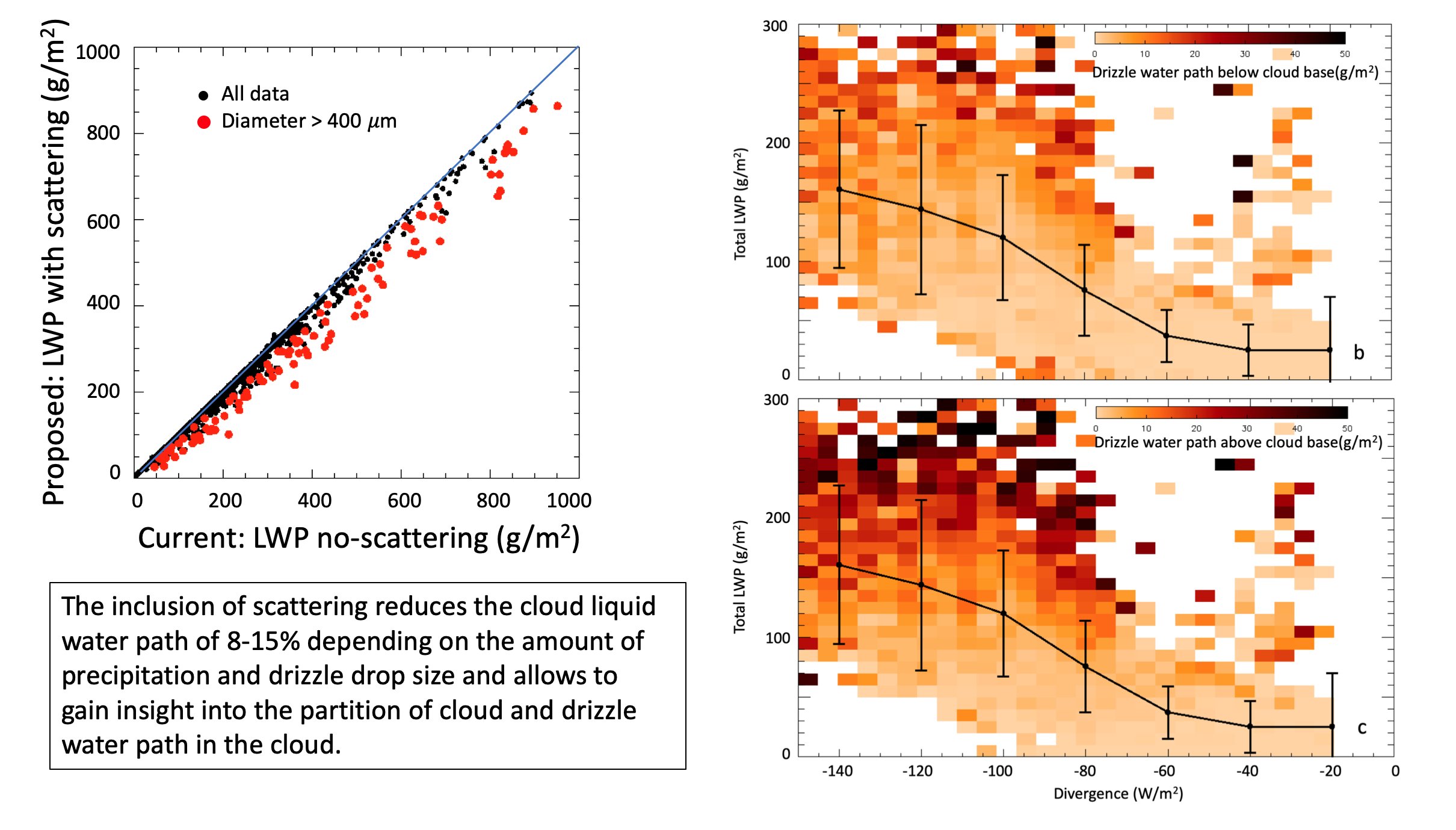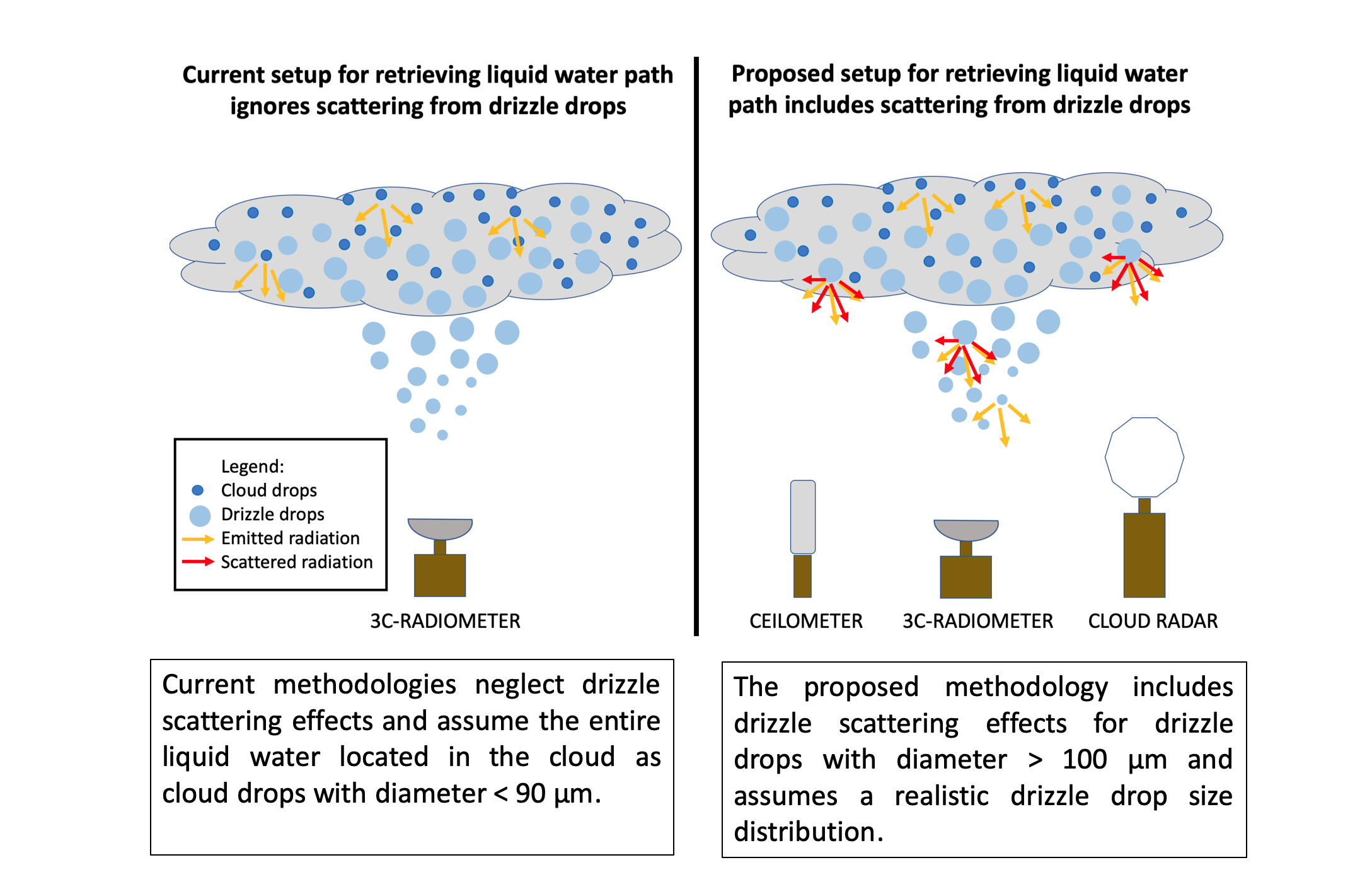Ground-based observations of cloud and drizzle liquid water path in stratocumulus clouds
Submitter
Cadeddu, Maria Paola
— Argonne National Laboratory
Ghate, Virendra Prakash
— Argonne National Laboratory
Area of Research
Cloud Distributions/Characterizations
Journal Reference
Cadeddu M, V Ghate, and M Mech. 2020. "Ground-based observations of cloud and drizzle liquid water path in stratocumulus clouds." Atmospheric Measurement Techniques, 13(3), 10.5194/amt-13-1485-2020.
Science

Figure 2. Left panel: Cloud liquid water path with and without accounting for drizzle drop scattering. Right panel: Drizzle water path above and below cloud base binned by total LWP and cloud divergence. From journal.

Figure 1. Current and proposed methodology for the retrieval of cloud and drizzle liquid water path in drizzling clouds. From journal.
Marine stratocumulus clouds reflect a greater amount of solar radiation back to space than the underlying ocean surface, thereby cooling the Earth’s surface. Hence stratocumulus clouds are an important component of the Earth’s radiation budget. Drizzle is ubiquitous in these clouds, with most of it evaporating before reaching the surface. Drizzle plays a key role in determining the cloud lifetime and cloud radiative properties, necessitating its accurate estimation within and below the cloud for characterizing aerosol-cloud-precipitation interactions.
In this study, profiles of drizzle properties below the cloud base, and integrated values of drizzle properties within the cloud, are estimated by combining data from active and passive remote-sensing instruments at the ARM Eastern North Atlantic (ENA) observatory.
Impact
The study advances our knowledge of drizzling clouds, which contribute substantially to model uncertainties. This is the first study that combined observations from active and passive remote-sensing instruments to yield radiatively consistent and physically realistic estimates of integrated cloud and drizzle water path in and below cloud base.
Summary
A technique to quantify cloud and drizzle water path by combining measurements from a three-channel microwave radiometer (23.8, 30, and 90 GHz) with those from a vertically pointing Doppler cloud radar and a ceilometer is presented. The profiles of drizzle properties below the cloud base are retrieved by combining the data from the Ka-band ARM Zenith Radar (KAZR) and the laser ceilometer. The retrieved profiles of drizzle properties and the microwave radiometer-measured brightness temperatures serve as an input to a sophisticated radiative transfer model to yield estimates of cloud and drizzle water within the cloud. The technique is then applied to 10 days each of precipitating closed and open cellular marine stratocumuli observed at the ARM ENA site.
In the closed cellular stratocumuli about 20% of the drizzle within the cloud falls below the cloud base, compared to about 40% in the open cellular stratocumuli. In closed cellular stratocumuli, drizzle below the cloud base is observed during conditions with radiative cooling at the cloud top of about 100 W/m2 and liquid water path greater than 200 g/m2. However, drizzle begins to form within the cloud at lower radiative cooling (~80 W/m2) and liquid water path ~120 g/m2, but does not fall below the cloud base. Our results highlight that neglecting scattering effects from drizzle drops leads to substantial overestimation of the total (cloud + drizzle) amount of liquid in these systems, a critical parameter used in studies focused on aerosol-cloud-precipitation interactions.
Keep up with the Atmospheric Observer
Updates on ARM news, events, and opportunities delivered to your inbox
ARM User Profile
ARM welcomes users from all institutions and nations. A free ARM user account is needed to access ARM data.


















